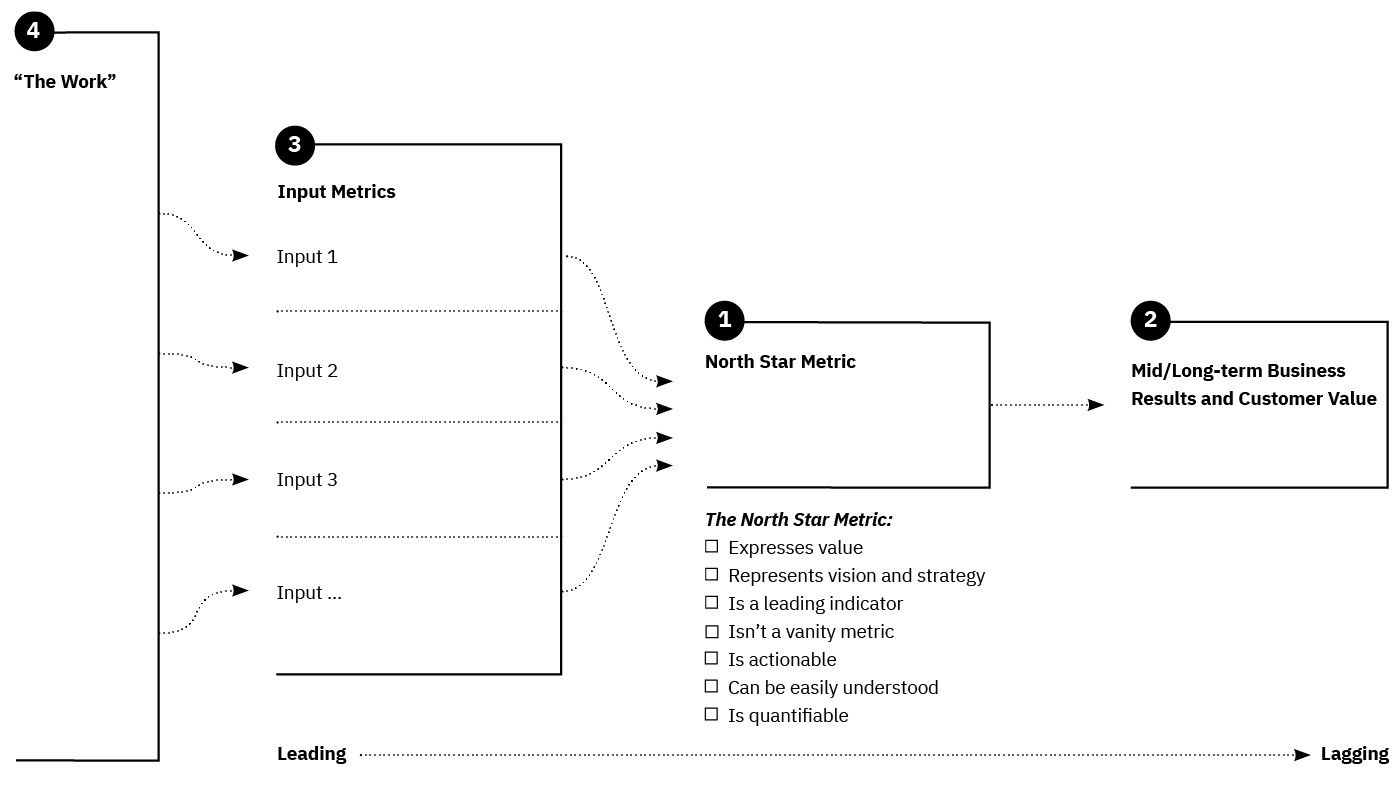North Star Framework
Helps achieve alignment on the 'why' and overall purpose.
Tim Beattie
Val Yonchev
What Is North Star Framework?
Creating a shared purpose for a product can be achieved by setting a North Star. The North Star Framework is a model for managing products by identifying a single, crucial metric known as the North Star Metric. According to Sean Ellis, who coined this term, this is the single metric that best captures the core value that your product delivers to customers.
The framework is equally useful for decisions related to the product as well as to operational aspects of the organization aligned to the product, e.g. Support, Customer Success, Product Marketing. The alternatives for a decision are evaluated against the potential impact on the metric.
Why Do North Star Framework?
The North Star Framework is the perfect tool for translating strategy into concrete product and organizational decisions with clear and measurable way to evaluate their effectiveness towards achieving the strategy.
Using the North Star practice during a discovery loop can help set teams off in the right direction and achieve alignment between all its members and its stakeholders. It can also help teams achieve course correction or re-alignment if they've been running without a North Star. Having a North Star's information radiated on the wall and clearly in view of team members and interested stakeholders can help maintain focus on it and steer the team toward it.
Amplitude is a digital analytics company that has freely released an excellent playbook regarding the North Star Framework – what it is, why you might use it, and how to use it. (check the links we love below)
It lists the following seven checklist points about what a North Star Metric is:
- It expresses value. We can see why it matters to customers reflected in it
- It represents vision and strategy. Our company's product and business strategy are
- It's a leading indicator of success. It predicts future results, rather than reflecting past results.
- It's actionable. We can take action to influence it.
- It's understandable. It's framed in plain language that non-technical partners can understand.
- It's measurable. We can instrument our products to track it.
- It's not a vanity metric. When it changes, we can be confident that the change is meaningful and valuable, rather than being something that doesn't actually predict long-term success, even if it makes the team feel good about itself.
How to do North Star Framework?
A team using the North Star Framework identifies a single, meaningful metric and a handful of contributing inputs. Product teams work to influence those inputs, which, in turn, drive the metric. The North Star is a leading indicator of sustainable growth and acts as connective tissue between the product and the broader business.
To help find a North Star, we make use of a simple canvas, such as the one provided in Amplitude's playbook:

You may want to consider several different topics in teams/organizations not experienced with the North Star Framework as a journey to get to a working framework:
- Understand strategy and key metrics of success
- Understand the customer journey and key moments and events of value creation and value realization
- Analyze metrics, incl. metrics of conversation to identify the leading indicators for the key events and moments, i.e. identify your North Star metric
- Build the North Star Framework by evaluating and linking the metric to all initiatives, major product features in the backlog, OKRs, etc.
If the chosen North Star metric doesn't check all of the boxes in the list mentioned earlier, you face a serious risk of wasting precious time, efforts and materials with limited impact on your business. A continuous evaluation of the whole sociotechnical system is essential for good results.
Who do you need
There isn't a predefined list of people, yet do consider that this practice aligns the whole organization to the strategy. As such you need multiple different perspectives to be represented, which we attempt to achieve by the following minimum roles listed:
- Chief/Head of product
- Product manager/s
- The product team/s
- Head of sales
- Product marketing
- Customer success
- Support
Suggested Time
As long as it takes, but time-boxed (60-120 minutes)
With experienced teams and facilitators, it can be all done in 120 minutes. Others may need a few workshops to gain alignment on key topics before completing the framework
Facilitation Materials Needed
A whiteboard and plenty of post-it notes.
Data, data, data - all of it in context of the user journey.
Tips for remote sessions
Use a virtual whiteboard. More sophisticated virtual whiteboards work better. We love Miro.com
Related Practices
The North Star framework integrates really well with many practices in the Discovery part of the loop:
- Impact mapping
- Service blueprint
- Journey maps
- OKRs
As key way to evaluate decisions, the North Star can be a great tool for integrating with practices in the Options pivot:
- Design Sprint
- Prioritization matrices
- Value Slicing
- Backlog Refinement
Look at North Star Framework
Links we love
Check out these great links which can help you dive a little deeper into running the North Star Framework practice with your team, customers or stakeholders.


